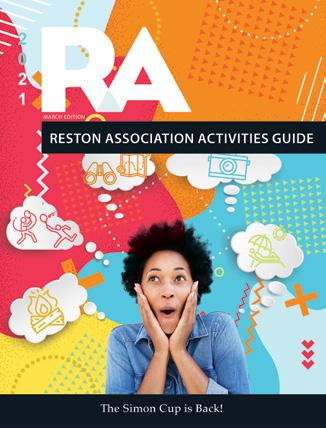
3 minute read
CONNECTING WITH RA
from Welcome to Reston
RA Activities Guide
Our quarterly guide provides members and non-members with a listing of all association programs and events as well as information about rentals, recreation passes and various seasonal recreational activities. Most listings provide codes that can be used to register or purchase products online at WebTrac. The guide is mailed to RA members and available online on our Issuu page. Go to https://issuu.com/restonassociation/ to read the online version of the guide.
Branching Out
This publication is produced quarterly by the association’s Walker Nature Center and communications team. Branching Out focuses on local environmental and wildlife topics. It also provides a seasonal calendar of fun and educational activities. Branching Out can be downloaded at https://issuu.com/restonassociation/
RA News
This electronic newsletter is emailed to approximately 8,500 subscribers for free every Friday. It includes news and notices regarding the association as well as links to events, meetings and Reston Today videos which air on our YouTube channel. We encourage all members keep informed by subscribing to RA News and following us on social media. Click here to sign up for RA News.

A LOOK INSIDE
• Calendar 4 • Kids’ Corner 6 •Outdoor Preparedness 7 •Holiday Greetings 8 Walker Nature Center
BRANCHING OUT
Nature Notes
By Pam Findley
DECEMBER
• Winter Solstice – Dec. 21—First day of winter • Look for bird and squirrel nests in the bare trees. • Spotted Wintergreen and Partridgeberry are evergreen. • Dark-eyed Juncos arrive from the north. • Witch Hazel begins to bloom. Peaks
Jan. –Feb.
JANUARY • Bald Eagles begin to nest. • Christmas Fern is evergreen. • Great Horned Owls begin breeding. • The constellation Orion is prominent in the evening sky. • Purple Finch, Hermit Thrush, and
American Robin dine on trumpet honeysuckle fruit.
FEBRUARY
• Striped Skunks breed. • Maple trees begin to bloom. • Eastern Red Cedar begins to bloom. • Eastern Bluebirds and Wood Ducks look for nest sites. • Full moon--Feb. 27—known as the
Snow or Hunger Moon.
Raccoon Tricks, Traits and Tails
By Susan Sims
Imagine hearing a loud sound at night as something crashes to the ground outside. Upon investigation, you find your garbage can overturned, contents strewn everywhere, and in the distance, the striped tail of a furry mammal running off into the night. Meet Mother Nature’s gluttonous athlete – the Raccoon.
Raccoons have a long connection to humanity from Native American legends to inspiring superheroes and minor league ball teams, even hanging out at the White House. It seems they’ve always rambled alongside us. The word raccoon comes from the Powhatan word arocoun, meaning, “he scratches with hands.” Etymology suggests this is from the animal’s habit of leaving scratches on trees as it climbs or its use of hands to explore objects.
The Raccoon (Procyon lotor) is a medium sized mammal native to North America and known for its intelligence and acrobatics. Raccoons range from 16 to 28 inches long and weigh anywhere between 10 to 30 pounds. They can climb down trees headfirst, hang from tree limbs and run up to 15 miles an hour. They boast stocky bodies with striped tails, thick gray fur and light colored bellies. Their dark masks span their faces. They may live up to 16 years, but generally between two to five years due to predator encounters and vehicle strikes.
Raccoon Senses and Adaptations
Raccoons have a highly receptive sense of touch. If you have ever seen one “washing” its food in water, then you have witnessed this sense in action. They use their front paws to investigate and interpret objects. Sensory input from the paws accounts for 65% of the section of the brain that processes the sensory intake. Studies suggest that water acts to increase the nerve response in their paws. They’re not actually washing their food; they’re learning about their environment!
Raccoons are omnivores and consume a wide variety of foods including insects, fish, plants, eggs and anything else they can find. Scientists believe their mask is an adaptation that helps the nocturnal animal see better in the dark by reducing glare. They also have a good sense of smell aided by a Jacobson’s organ, which helps them sniff out hidden food sources, whether that’s acorns, bird seed or donuts. They’re also highly intelligent. Scientific studies found that raccoons learn to problem solve to access something they want. Continued on page 2
Winter | 20-21 | Volume Twenty Two







